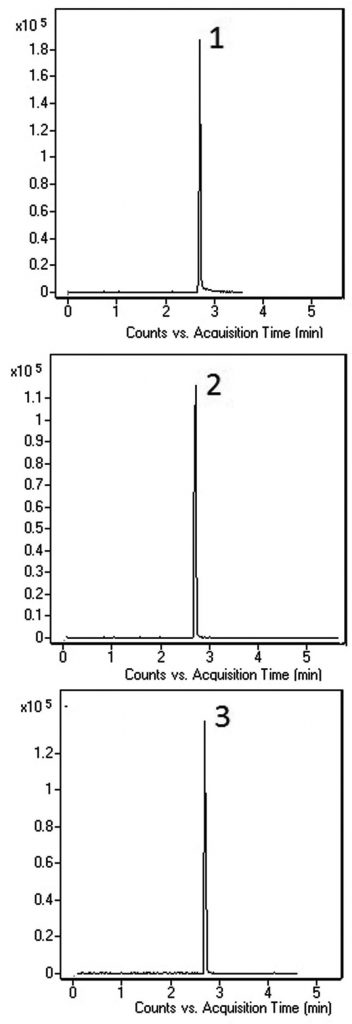Glufosinate, N-Acetylglufosinate, and Glufosinate Propanoic Acid
Analysis of these Compounds can be problematic with other methods and poor peak shape may occur. In contrast, the Peaks obtained in this method are very sharp and symmetrical and can be applied to food products containing these types of Compounds.

 Peaks:
Peaks:
1. Glufosinate m/z 180.0431 [M-H]–
2. N-Acetylglufosinate m/z 222.00 [M-H]–
3. Glufosinate Propanoic Acid m/z 151.00 [M-H]–
Method Conditions
Column: Cogent Diamond Hydride™, 2.2μm, 120Å
Catalog No.: 70200-05P-2
Dimensions: 2.1 x 150mm
Mobile Phase:
—A: DI Water / 10mM Ammonium Acetate
—B: 95% Acetonitrile / 5% DI Water / 10mM Ammonium Acetate (v/v)
Gradient:
| Time (minutes) | %B |
| 0 | 90 |
| 1 | 90 |
| 1.2 | 5 |
| 5 | 5 |
| 6 | 90 |
Post Time: 3 minutes
Flow rate: 0.4 mL/minute
Detection: ESI – NEG – Agilent 6210 MSD TOF Mass Spectrometer
Injection vol.: 1μL
Sample Preparation: Glufosinate (1720.64 ppm), N-Acetylglufosinate (639.2 ppm), and Glufosinate Propanoic Acid (1302.5 ppm) stock solutions were diluted 1:100 with 4:1 DI Water: Methanol
t0: 0.6 minutes
Note: Glufosinate is an Herbicide which acts by interference with the Ammonia detoxification metabolic pathway. Trade names of formulations featuring the compound include Rely®, Finale®, and Ignite®.
Attachment
Herbicide and Metabolites by LC-MS pdf Download File


